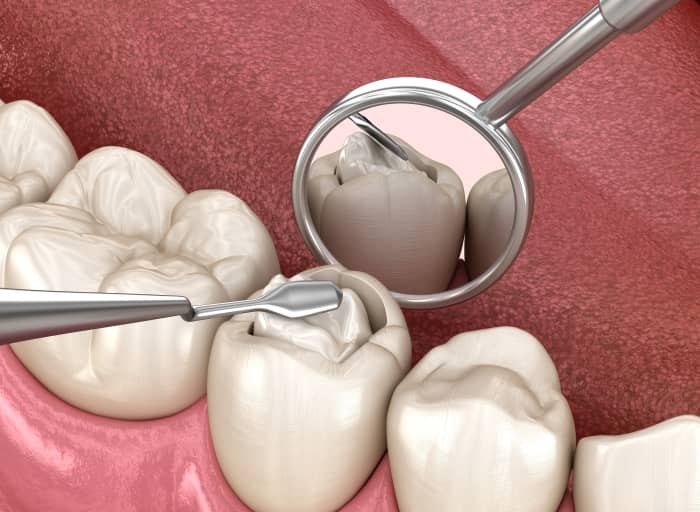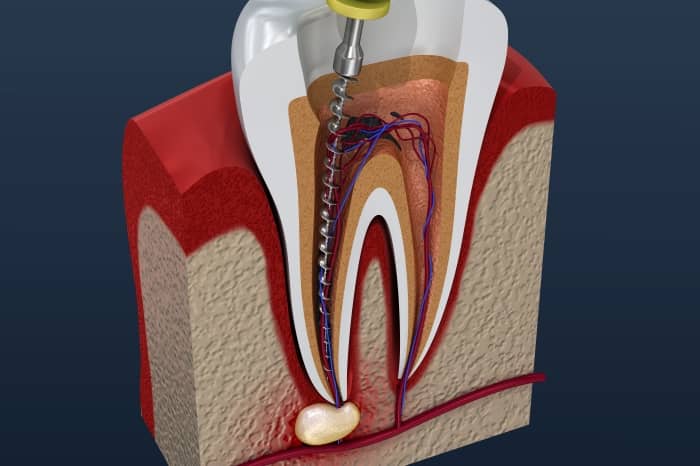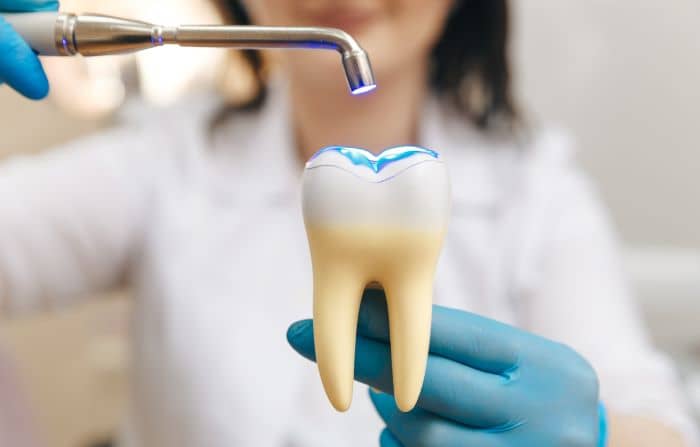The mouth is teeming with bacteria that can form a sticky film known as plaque.bIf plaque builds up, it creates acids that damage tooth enamel and lead to decay.
The longer decay goes untreated, the more severe the side effects can be. Dental fillings and root canals are common treatments for addressing decay. But what is the difference between root canal treatment and dental fillings?
In this article, we’ll cover the difference between these common dental procedures, including frequently asked questions and signs you need a root canal or filling.
What Is A Dental Filling?
A dental filling is a simple, fast procedure that effectively addresses decay and prevents further oral health complications.
A dental filling involves cleaning out the decay in the affected area and filling it to prevent further damage and restore the biting surface.
The early signs of tooth decay can be easy for an individual to miss. Dentists check for tooth decay at every checkup, making it crucial to schedule regular dental exams. The earlier decay is recognised and treated, the better the outcome.

What Is A Root Canal?
Inside every tooth, there are tiny spaces known as root canals. Root canals contain dental pulp, an area rich with blood vessels and nerves.
If the dental pulp becomes damaged due to decay, disease, or trauma, the root canal can become infected. This can result in pain, swelling, and the spread of the infection.
What Is Root Canal Treatment?
In the past, the only treatment for teeth with damaged pulp was removal. Fortunately, root canal treatment can clean the infected pulp and repair the root canal, allowing patients to keep a damaged tooth rather than get it removed.

How to Know If You Need Root Canal Treatment or a Filling
Only a dentist can determine if you need root canal treatment or a filling, but there are some signs to watch for. Shared symptoms include pain, swelling, toothaches, and sensitivity.
While the symptoms are similar, the severity is usually worse when root canal treatment is required. This is due to the damage to the sensitive nerves and blood vessels in the root canal system.
Possible signs you need a filling:
- Toothaches
- Increased sensitivity to hot or cold temperatures
- Minor cavities
- Dark spots
Possible signs you need a root canal:
- Extreme sensitivity to hot or cold beverages or foods
- Moderate to severe tooth pain
- Cosmetic changes to the teeth, such as dark spots
- Tooth damage, a fractured tooth, a loose tooth, or damage to dentures or crowns
- Swollen gums or facial swelling
- Pain when chewing and biting down
What Is the Cost Difference Between Root Canals and Fillings?
Because of the additional work required, root canals are more expensive than fillings. The cost of root canal treatment or a dental filling depends on the individual, how many teeth are affected, and the extent of the damage. The cost of fillings also depends on the material used.
What Factors Contribute to Infected Pulp?
Several factors put a tooth at risk of pulp infection, including:
- A crack, chip, or fracture in the tooth
- Extreme wear
- Extensive decay
- Trauma
- Repeated procedures to the same tooth
Do Root Canals Hurt More Than Fillings?
Dental filling and root canals should both cause little to no discomfort. Before either procedure, the affected area is numbed with a local anaesthetic.
Once the local anaesthetic wears off, both procedures may cause mild to moderate discomfort, including sensitivity or swelling. All symptoms should be gone within a few days.
For the first day or two after either treatment, it is recommended to only consume soft foods, get plenty of rest, and avoid exercising. Ask your dentist about over-the-counter medications to manage any discomfort.

Can you Get a Filling Before a Root Canal?
If there is no root canal system damage, you can get a dental filling to address the decay. However, if the pulp of the tooth is infected or inflamed, it must be addressed first. Otherwise, a filling placed over an infected tooth would allow further deterioration and complications.
How Long Does A Root Canal Procedure Take?
Root canal treatment typically involves a total of 1 to 3 visits to your dentist. The actual procedure takes around 30 to 90 minutes.
How Long Does a Filling Take?
A dental filling can be completed in a single visit. The procedure typically lasts anywhere from 20 minutes to an hour depending on the area being treated and the extent of the decay.
What Happens During a Filling Procedure?
First, the tooth and the surrounding area are numbed using a local anaesthetic. Next, a high-speed dental tool is used to remove all decay, with a focus on maintaining as much of the natural tooth structure as possible.
The cavity is then disinfected and dried completely. Then, the filling material is put in place. Composite resin is the most commonly used filling material. Once hardened, the tooth is polished to match your bite and your surrounding teeth.

How Long Does It Take To Recover From A Root Canal Treatment or Filling?
Generally, recovery from a dental filling is faster than from root canal treatment, but both procedures involve minimal recovery time. You should be back to normal within a few days.
What Happens If You Leave Decay Untreated?
Left untreated, decay can lead to serious oral health complications. If the pulp of the tooth becomes infected, bacteria can travel through the tooth roots and infect surrounding tissues such as the jaw and gums. This can lead to painful abscesses.
In severe cases, inflammation and infection can travel throughout the body and lead to conditions such as heart disease. Other complications of untreated decay include tooth loss and gum disease.
What Are the Alternatives To a Root Canal?
The only alternative to a root canal is having the tooth extracted. However, tooth extraction comes with possible side effects, including:
- Changes to the bite
- A gap that allows the surrounding teeth to shift
- The need for a bridge or implant
When possible, keeping a natural tooth is always a priority.
Can I Eat After A Root Canal or Dental Filling?
After root canal treatment or a dental filling, it is important to wait to eat until any numbness wears off. Otherwise, you risk biting your tongue or cheek. It is usually recommended to stick to soft, cold foods for the first couple of days after either treatment.
The best foods to eat after a root canal include soft options such as eggs, soup, fruit smoothies, pears, mangos, or bananas. It is recommended to stay away from chewy, sticky, crunchy, or hard foods. Hot or spicy foods are also best avoided for the first few days.
How to Prevent Tooth Decay
A good oral hygiene routine can significantly reduce your chance of needing a dental filling or root canal treatment.
Here are steps to a good oral hygiene routine:
- Brush your teeth twice a day using a fluoride toothpaste
- Floss at least once a day (read more about the importance of flossing here)
- See your dentist for regular checkups
- Eat a healthy diet rich in fruits, vegetables, and whole foods
- Limit the consumption of acidic, sugary beverages
- Use an antibacterial mouthwash once a day
- Brush your tongue at least once a day

Are You Experiencing Signs of Tooth Decay?
Root canal treatment and dental fillings are effective, painless procedures that offer significant oral health benefits. If you are experiencing sensitivity, toothaches, or any other signs of decay, contact us right away.






